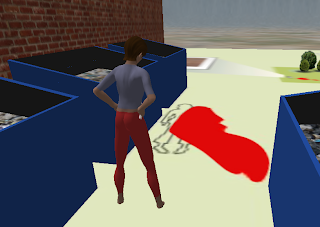I strongly believe that in training situations, virtual environments should only be used to 'fill in the gaps' for things that can't be done in the real-world. For example in this case, it's unlikely that a department would be able to provide a restaurant and alleyway for students to investigate; and impossible to have 20 such environments, so that all students can perform the exercise at the same time. This is what the virtual environment provides.
However, in using the environment I would argue for a system similar to a murder mystery event that I recently attended:
- Students explore the environment gathering virtual evidence.
- At the end of the exercise a list of reference codes is given for the virtual evidence.
- Tutors give students real evidence based on these references.
I think that this system has a good clear division between gathering (virtual) and analysing (real); which would obviously need to be supported with real-world evidence gathering exercises - but these could be on a smaller scale focusing on skills rather than the environment.
Without wanting to waffle too much, it could be taken to the extreme, where students are given physical props when they encounter the virtual counterpart. Act-UK have a system in this style, developed by make-media; where a cave-style technology provides the environment and real-life actors and props form the foreground.
Virtual Blood Sampling
However, using the above method wouldn't leave me with much to do, and so I've created a virtual blood sampling system as an alternative. As with the UV light, the student must equip the swab to the avatar, and can then click on the object to sample (in the image below it is the victims blood).

The student is then given a sample, which is stored in their inventory. These can be given unique id's for use in the afore-mentioned method, or the student can be tasked with assigning them names and recording where they were taken.
These samples can then be dropped onto the centrifuge; where various characteristics are reported back.

No comments:
Post a Comment